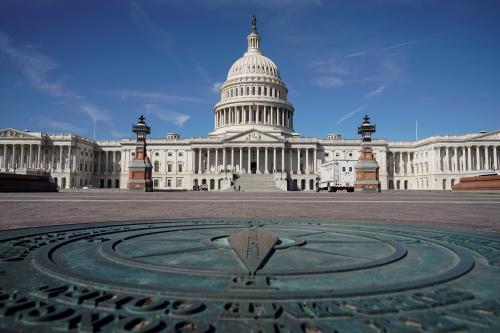My mother, long before she died at age 92, ran through both Social Security and her retirement money. She wasn’t unusual: the Employee Benefit Research Institute (EBRI) estimates that, even with Social Security, some 40+% of us will run out of money in retirement.[1]
Why does this happen to so many? Often it’s because there’s no savings plan where people work, or if there is, they don’t use it. The most effective way for people to save more is for them to be enrolled automatically in a payroll savings plan (from which they can opt out) and to require their employers to offer a plan and enroll them. That’s the approach taken in the UK and elsewhere, but here we don’t require anything and most of America’s smaller businesses don’t offer anything. As a result, at least 50 million Americans are working full-time without any workplace saving beyond Social Security. We could change this, quickly and easily, by paying employers to sign their employees up for IRAs.
The financial services industry points out, accurately, that it offers thousands of savings plans, but most small businesses won’t have anything to do with ERISA[2] retirement plans, whether pensions or “401k’s”; they don’t want the employer contribution, the administrative cost, or the reporting and other regulatory requirements.
Members of Congress have repeatedly proposed requiring reluctant employers to offer payroll savings, but there’s steadfast bipartisan opposition to such a mandate. Nor, despite lots of wishful thinking, is a requirement likely to succeed using the budget reconciliation process.[3]
Even with Social Security, some 40+% of us will run out of money in retirement.
Incentives for ERISA retirement plans haven’t worked. Recognizing this opposition (even if not always admitting it), Congress turned to financial incentives, repeatedly offering employers both regulatory relief[4] and generous tax credits[5] if they start an ERISA plan. These efforts, well-intentioned and bipartisan, haven’t done much. According to EBRI, we have a $3.8 trillion retirement shortfall, but the 2019 SECURE Act–the most significant retirement bill in over a decade–will reduce it by only about 3%.[6] Despite years of encouragement and billions in incentives, most small businesses just won’t sign up, even for ERISA-lite.
IRAs are accepted where ERISA plans are not. If we’re going to get to universal savings, therefore, we need something else that doesn’t come with ERISA’s baggage: an IRA. Individual retirement accounts have been around for decades. They’re no one’s idea of an ideal retirement program–they don’t even allow employer contributions and lack many ERISA protections–but they can work. And, while Washington dithered, several states have figured out how to make them work.
State “secure choice” auto-IRA programs were designed to overcome small business objections: they involve no employer contributions, do not charge employers to participate, and are exempt from ERISA reporting and regulatory requirements. All employers have to do is provide their employee list and agree to payroll deductions for employees that don’t opt out. Already more than 300,000 people are using these programs in the three states that are up and running and have saved more than $200,000,000. A survey of businesses using Oregon’s program found almost three quarters accepted the approach[7], and many more such programs are in the works.
The state programs are designed to offer better retirement security than private IRAs. They are operated using professional private management but on a larger scale and at lower costs. In addition, because the programs have a legal fiduciary obligation[8] to savers under state laws, they pay attention to savers’ needs in ways that firms offering private IRAs do not. Maryland’s program, expected to start this December, will offer both a “rainy day” emergency savings account and, at retirement, the choice of an automatic monthly paycheck as well as other options. (Disclosure: I chair Maryland’s program.)
IRAs have other advantages. They’re portable: People can keep contributing to the same account and don’t have to change when they either changes jobs or add a second one.
IRA programs can be used for more than just retirement savings. Those that are designed as Roth IRAs allow withdrawals of principal without a tax penalty. That means they can be used both for retirement savings and for emergency or “rainy day” needs, too. In fact, each state auto-IRA program thus far includes a separate account, generally invested in money market funds, that can cover short-term needs while preserving the separate retirement funds. In essence, auto-IRAs can facilitate general saving, not just saving for retirement.
Congress provides tax credits if businesses start ERISA plans but not IRAs–the one form of workplace savings that small businesses are most likely to accept.
What’s missing? A financial incentive for businesses to sign their employees up for IRAs. For businesses that offer no retirement program, the primary reason cited is cost (a.k.a. “resources”). Even though the state auto-IRA programs do not charge, about a quarter of employers report significant out-of-pocket costs (see footnote 7). Private IRA and other programs have more significant employer charges.
In its efforts to increase retirement savings, Congress provides tax credits if businesses start ERISA plans but not IRAs–the one form of workplace savings that small businesses are most likely to accept. Congress can and should provide at least some credit for participation in state or private auto-IRA programs, too.
How to Support IRAs While Maintaining the Preference for ERISA Plans
Importantly, small business IRA credits can be designed to comply with budget reconciliation requirements, whereas an IRA mandate probably cannot.
The current program of ERISA-only employer tax credits can be modified in a way that maintains the nation’s strong preference for employer contributions via ERISA plans, yet encourages use of IRAs where companies are otherwise unwilling. Here’s how:
- To encourage employer contributions and use of ERISA plans, provide the largest credit for starting or joining an ERISA plan and providing an employer match.
- Provide a lesser incentive for joining state-created fiduciary auto-IRA programs, and a still smaller but substantial payment for a private auto-IRA.
Within the category of IRAs, it’s important to recognize that all of the state-sponsored programs act as fiduciaries for savers, while providers of private IRAs generally do not. Furthermore, state auto-IRA programs generally operate at much lower fees than private IRA’s. For these reasons, the credit should be greater for the state-sponsored programs.
It’s also important that the credit be a fixed amount and not be limited to employer out-of-pocket expenses. Otherwise, the option that is lowest cost overall and lowest cost to employers–the state auto-IRA programs–will instead be seen by them as most expensive.
Appendix 1 provides an example how such a credit could be structured.
Appendix 1: Possible Credit Design
The amount of the credit should depend on whether or not an employer provides an ERISA plan and makes matching contributions, on how many employees are enrolled, and, if an IRA program, whether that program is sponsored by a state-created entity operating under fiduciary standards. Here’s a possible example:
- Employers of up to 100 employees (and payors of up to [500] gig workers/independent contractors) will receive a tax credit for setting up an automatic enrollment savings plan.
- Employers joining a PEP or other ERISA plan and that match[9] employee contributions: $350 each for up to 75 participating employees[10] per year for each of three years.
- Employers that do not match contributions, $250 per year for each participating employee (up to 75 employees) for each of three years.
- Employers joining an automatic-enrollment payroll deduction IRA program operated by a state instrumentality acting as a fiduciary: $200 per participating employee (with a maximum of $[10K] per year) for each of three years
- Employers joining another automatic-enrollment payroll deduction IRA program: $100 per participating employee (with a maximum of $[4K] per year) for three years.
- Employers that already have a plan or program but that doesn’t auto-enroll will, if they commence autoenrollment, receive the autoenrollment credit provided under the SECURE Act for two years.
- In order not to disadvantage the state auto-IRA programs, which by design move program costs from employers to employees, the credits should be fixed and not limited to the employer’s out-of-pocket expenses.
[1] VanDerhei, Jack, EBRI Retirement Security Projection Model®(RSPM) – Analyzing Policy and Design Proposals (May 31, 2018). EBRI Issue Brief, May 31, 2018 • No. 451, SSRN: https://ssrn.com/abstract=3240062
[2] The Employee Retirement Income Security Act (ERISA), first enacted in 1974, was intended to facilitate use of traditional pensions under which employers guaranteed lifetime income payments. However, most businesses responded to its requirements by abandoning such pensions and, in some cases, switching to individual account “defined contribution” plans under which ERISA requires that employers, if they contribute at all, are not responsible for guaranteeing any result at retirement.
[3] Under the “Byrd rules” contained in the Congressional Budget Act, non-budgetary items are excluded from budget reconciliation bills.
[4] In the Setting Every Community Up for Retirement Enhancement (SECURE) Act of 2019, Congress authorized creation of “pooled employer plans” (PEPs) that removed both ERISA reporting requirements and fiduciary obligations from employers. The Congressional Budget Office, estimating the effects of the program, concluded that PEPs would add proportionately few new plans.
[5] The SECURE Act also substantially increased the tax credits for employers joining an ERISA plan, so that businesses who join get $250 per employee (up to $5,000 total) for 3 years, plus a $500 auto-enrollment startup credit.
[6] VanDerhei, Jack. 2020. “How Much More Secure Does the SECURE Act Make American Workers: Evidence From EBRI’s Retirement Security Projection Model®,” EBRI Issue Brief, no. 501 (Employee Benefit Research Institute, February 20, 2020) How Much More Secure Does the SECURE Act Make American Workers: Evidence From EBRI’s Retirement Security Projection Model®
[7] Pew Memorial Trusts. 2021. “OregonSaves Auto-IRA Program Works for Employers” (April 2, 2021) Issue Brief. OregonSaves Auto-IRA Program Works for Employers | The Pew Charitable Trusts (pewtrusts.org)
[8] The state programs are not regulated by ERISA, which is an important reason why they are more acceptable to small businesses. However, every state program imposes a fiduciary requirement under state law. These fiduciary protections are significant.
[9] The Department of Treasury, consulting with the Department of Labor, would determine a minimum level of matching to qualify for the higher credit.
[10] To encourage employers, in the first year all employees auto-enrolled could be considered participating. After year 1, employees are considered participating for the year if they do not opt out within 60 days. The Department of Treasury, in consultation with the Department of Labor, could have the ability to modify these requirements by regulation to achieve the purposes of the credit.





Commentary
If we want universal savings, pay employers to sign us up for IRAs
June 16, 2021